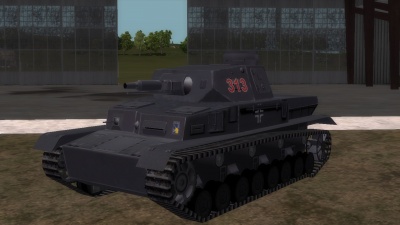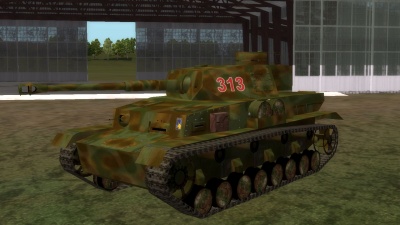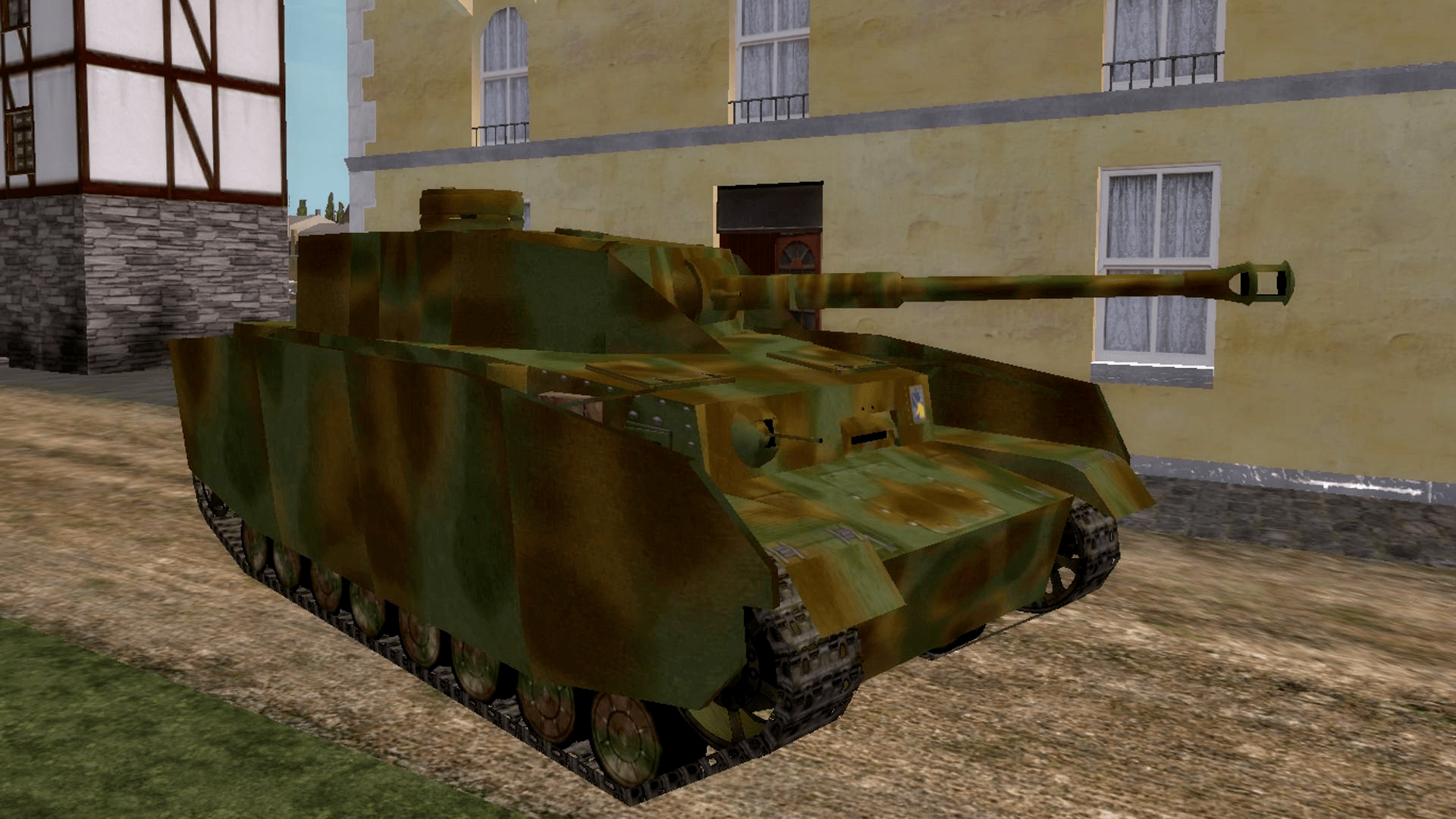Difference between revisions of "PzKpfw IV"
| Line 239: | Line 239: | ||
. The PZ IV H is a highly useful combination of mobility, frontal armour, and an accurate and lethal main gun that can kill any Allied tank at significant ranges. This is however NOT the tank that you take down into a contested town leave that to the cheaper and more versatile PZ Ill family. Your skits look nice but do not let them fool you into thinking that your sides are well protected: they are anything but. Key to success is your ability to shoot and scoot, to stay well away from enemy infantry and under cover from Allied fighter-bombers. | . The PZ IV H is a highly useful combination of mobility, frontal armour, and an accurate and lethal main gun that can kill any Allied tank at significant ranges. This is however NOT the tank that you take down into a contested town leave that to the cheaper and more versatile PZ Ill family. Your skits look nice but do not let them fool you into thinking that your sides are well protected: they are anything but. Key to success is your ability to shoot and scoot, to stay well away from enemy infantry and under cover from Allied fighter-bombers. | ||
The Panzer IVH appears on the battlefield in tier 3. | |||
[[Category:Armor]] | [[Category:Armor]] | ||
Revision as of 10:36, 22 September 2020
PzKpfw IV Ausf. D
History
| 400px | |
| Main Gun Optics | |
| Specifications | |
| Designation | TZF 5b |
| Magnification | 2.4x |
| Field of View | 23.5° |
Most military historians accept Colonel-General Heinz Guderian as the architect of the German Panzertruppe (armoured force) that fought World War II. The Panzerkampfwagen IV (Armoured Fighting Vehicle IV; shortened to Panzer, Pz, or - officially -PzKpfw IV), Guderian’s brain child of the mid 1930s, incorporated and balanced fairly well the three main qualities a tank needed to succeed on a contemporary battlefield: mobility; protection; and firepower. The PzKpfw IV was to become the most numerous of German World War II tanks. In all, over 8,500 examples were produced.
The PzKpfw IV was borne of a requirement posted by the Heereswaffenamt (Army Weapons Branch) during 1934-35. The specification called for a medium tank to support PzKpfw III units and infantry, with an overall weight of some 18 tonnes, a top speed of 35 km/h (22 mph), and a short 7,5cm (2.95in) Kampfwagenkanone (Fighting Vehicle Cannon; Kw.K.) 37 L / 24 gun as main armament.
Krupp, Rheinmetall-Borsig, and Maschinenfabrik-Augsburg-Nürnberg AG (MAN) all competed for the contract. The Heereswaffenamt selected Krupp’s design for full-scale production after testing at Kummersdorf and Ulm during 1935-36 but it wasn’t until after extensive trials of various prototypes that the first of 35 PzKpfw IV Ausf. As rolled off Krupp’s production line at Gruson, October 1937. The suspension consisted of a forward drive sprocket, four pairs of road wheels with leaf springs, and a rear idler with four return rollers. A 12-cylinder Maybach HL 108 TR petrol engine drove the forward drive sprockets through a five-speed transmission with an epicyclic clutch. An auxiliary generator powered the turret traverse. The commander’s cupola was supplied with eight vision slits. The crew was provided with numerous vision slits and pistol ports. In front, the superstructure on the left (driver’s side) jutted ahead of the radio operator on the right side and allowed the driver an unblocked view over the hull through a hatch to his right.
Between April and September 1938, Krupp produced 42 PzKpfw IV Ausf. Bs at its Gruson plant. The Ausf. B replaced the Ausf. A’s Maybach HL 108 TR 12-cylinder engine with a slightly different but equally powerful Maybach HL 120 TR and used a transmission with one more forward gear. Armour thickness increased and the turret sported a new commander’s cupola. The superstructure front in the Ausf. B maintained a clean line, eliminating the driver’s right-hand hatch. The bow machine gun was removed.
Carrying on from Ausf. B, Ausf. C production ran to 134 examples built between October 1938 and August 1939. This model incorporated a redesigned gun mantlet with an armoured sleeve for the coaxial machine gun. The engine was modified to improve the carburetor.
The Ausf. A, B, and C were considered development models, most of which nonetheless ended up with front-line combat units. They saw extensive use, albeit in limited numbers, during the Polish and French campaigns.
The Ausf. D was considered to be the first true production model of the PzKpfw IV series. It received thicker armour and an external mantlet for the main gun. The superstructure front reverted to Ausf. A form and the bow machine gun was re-introduced. Krupp produced 229 between October 1939 and May 1941 and 233 Ausf. Es from September 1940 to April 1941. The Ausf. E featured increased armour protection along with a redesigned commander’s cupola. Its turret rear was manufactured from a single, curved armour plate and bore an exhaust fan to expel ammunition fumes. The superstructure returned to a straight front.
The Vomag and Nibelungenwerke factories started producing PzKpfw IVs with the Ausf. F, manufacturing a small minority of the 487 Ausf. Fs built between April 1941 and March 1942. This early version of the Ausf. F, called the Ausf. F1, was the last of the PzKpfw IV series to use the Kurz (short) chassis and the short 7,5cm Kw.K. 37 L / 24 gun. Again the armour thickened and the F1 rode on wider, 40cm (15.7in) tracks. Vision ports, turret doors, pistol ports, and machine gun mounts were all redesigned due to the increased armour thickness.
The short-barrelled PzKpfw IVs were effective assault tanks, but the short barrel and low velocity made it inaccurate and ineffective at medium to long range against small, hard targets such as enemy tanks. While nothing could make the short barrel gun more accurate, the introduction of the 7,5cm HEAT round somewhat increased its lethality in the anti-tank role. Relatively fast for its size, it remained popular with troops and provided a sound chassis upon which better tanks would be designed and built.
Game Play
The PzKpfw IV Ausf. D is slightly larger than the PzKpfw III series, and is essentially a good medium tank hampered by a truly inaccurate gun. The dispersion on long-range shots is bad enough that your ample ammunition depletes quickly as you try to hit any tank-sized target at distance. The HEAT (High Explosive Anti-Tank) rounds are lethal against all allied armor - even the heavy stuff like the B1 bis or Matilda - but you don't carry many, so you must be skilled and accurate when you decide to use them. Every miss will alert the enemy to your attack and your armor will not withstand a lot of return fire if it is accurate and at medium range or closer. Furthermore, the AP, HEAT, and HE rounds all have different ballistic properties, so you will need to practice to know what performance to expect from all the various rounds. Typically, HE and HEAT don’t fly as far or as flat as AP does.
The range sights are set for AP shells, the most plentiful type of ammunition. It’s not a bad idea to range a target with AP, then increase your elevation slightly before firing HE or HEAT for effect. The extremely short barrel of the Kw.K. 37 L / 24 limits your precision to short range. Your armor is not much better than that of a PzKpfw III, and you might find enemy AP rounds lethal well before you’re able to score a clean hit. The PzKpfw IV Ausf. D is reasonably fast, a good tank to bring if armor’s needed in a hurry. In urban combat, its short gun is less of a detriment, and can be quite a pleasure to use with its exceptional lethality at short ranges.
the Panzer IVD is available from tier 0.
Armor
| Location | Thickness | Angle |
|---|---|---|
| Hull front | 30 mm | 12° |
| Hull sides | 20 mm | 0° |
| Hull rear | 20 mm | 10° |
| Hull top | 10 mm | 90° |
| Superstructure front | 30 mm | 7° |
| Superstructure sides | 20 mm | 0° |
| Superstructure rear | 20 mm | 10° |
| Superstructure top | 12 mm | 85°-90° |
| Turret front | 30 mm | 10° |
| Turret sides | 20 mm | 25° |
| Turret rear | 20 mm | 0°-25° |
| Turret top | 10 mm | 83°-90° |
| Gun mantlet | 35 mm | 0°-29° |
PzKpfw IV Ausf. G
History
| 400px | |
| Main Gun Optics | |
| Specifications | |
| Designation | TZF 5f |
| Magnification | 2.4x |
| Field of View | 25° |
The appearance early in the war of the heavier Allied tanks like the Matilda and B1 bis was a slight shock to German designers. Numerous combat reports from battles waged in France sent them develop ways to mount better guns on their tanks.
The PzKpfw IV was equipped with a large turret ring, which made the mounting of the much longer 7,5cm Kw.K. 40 L / 43 gun a simple task. This potent weapon had far higher muzzle velocity than the shorter 7,5cm gun, which increased long-range accuracy and penetration. Varieties of the long-gunned PzKpfw IV remained successful tanks through the rest of the war.
Following the Ausf. F1, all variants were based on the Lang (long) chassis and bore the more capable main gun. Production of the Ausf. F2, or “Mark IV Special” as the British called them in North Africa, ran to 200 examples. The Ausf. F2 and the concomitant 1,275 early Ausf. Gs, surpassed any British or American tank design at the time and Allied troops generally treated them with a great deal of respect on the battlefield. Other minor modifications included a new muzzle brake and the elimination of vision ports from the turret sides and from in front of the loader. From March 1943, the factories rolled out an additional 412 PzKpfw IV Ausf. Gs armed with the much newer and improved 7,5cm Kw.K. 40 L / 48 .
Between April 1943 and July 1944, German industry produced 3,774 examples of the PzKpfw IV Ausf. H, armed exclusively with the 7,5cm Kw.K. 40 L / 48 and and carrying 80mm (31.5in) frontal armor. Armour on the sides and rear remained relatively thin, a throwback to the earlier variants that left all PzKpfw IV models vulnerable to flank attacks, something that Allied gunners would learn to use to great effect. Other improvements in the Ausf. H included SSG transmission, and external air filters. The side vision ports for the driver and radio operator were deleted. A new, more thickly armored cupola featured a single-piece hatch.
From June 1944 until the end of hostilities in Europe, Nibelungenwerke produced 1758 PzKpfw IV Ausf. Js, a variant similar to the Ausf. H but employing a rationalized design to simplify production. The primary difference was the removal of the electric turret traverse in favor of a manual system.
The PzKpfw IV certainly wasn’t the best tank in its class during World War II - the Soviet T-34 earns that accolade - but in the hands of an experienced crew, it was certainly a deadly weapon, one which Allied crews learned to ignore at their peril. More PzKpfw IVs served in World War II than any other German tank. It was the only German tank to be manufactured throughout the war, eventually totaling more than 8,500 examples.
Game Play
The PzKpfw IV Ausf. G became the mainstay of German armored divisions for good reason. It was a useful combination of mobility, frontal armor, and an accurate, lethal main gun that could kill any Allied tank at significant ranges. Together, these advantages make the Ausf. G an effective all-around weapon in almost any situation.
Keep in mind that you have a tremendous range advantage over most other tanks you will be in combat with, and very good quality sights. This is not the tank that you take into a hotly contested town – it’s far too valuable to be subjected to dangerous quarters prone to short-range ambush. Instead, sit at extended ranges, nearly impervious to frontal return fire; and kill almost any tank you see. The camo paint scheme on your tank gives you much greater concealment and surprise advantages than the earlier grey schemes of Axis armor, but it also means it will stand out as a particularly high-value target to Allied aircraft and anti-tank units. Keep moving, firing, and relocating in order to minimize the ability of the enemy to focus ground or aerial resources effectively to eliminate you.
Many Axis tankers in Battleground Europe assume they are almost invincible when driving the Ausf. G and indeed in many instances it may appear this is true. However, your armor is really only difficult to penetrate from the front, and even the relatively small 40mm QF 2pdr guns on early British tanks will poke holes in you on the sides and rear. Even the larger early French tanks can use their 47mm guns to end your combat quickly from the sides or rear. Be alert for the quick little M3A3 Stuart, which can get beside or behind you in a hurry and end your sortie with its high-velocity 37mm M6.
The panzer IVG is available from tier 2.
Armor
| Location | Thickness | Angle |
|---|---|---|
| Hull front | 50 mm | 12° |
| Hull sides | 30 mm | 0° |
| Hull rear | 20 mm | 10° |
| Hull top | 10 mm | 90° |
| Superstructure front | 50 mm | 10° |
| Superstructure sides | 30 mm | 0° |
| Superstructure rear | 20 mm | 12° |
| Superstructure top | 12 mm | 85°-90° |
| Turret front | 50 mm | 11° |
| Turret sides | 30 mm | 26° |
| Turret rear | 30 mm | 10° |
| Turret top | 15 mm | 83°-90° |
| Gun mantlet | 50 mm | 0°-30° |
PzKpfw IV Ausf.H
History
| 400px | |
| Main Gun Optics | |
| Specifications | |
| Designation | TZF 5f |
| Magnification | 2.4x |
| Field of View | 25° |
The Ausf.H was equipped with the new long caliber KwK 40 L/48, and was subsequently registered as the Sd.Kfz. 161/2 by the ordnance department. Other modifications included simplifications to ease production, like the removal of the hull side vision ports, and, later, part sharing with the Panzer III. This was by far the biggest production of the type, with a total of 3774 machines, until its replacement by the Ausf.J, in June 1944. Krupp had received a request, in December 1942, for a new version featuring all-sloped armor, which would have also required a new chassis, transmission and probably engine as well, due to the added weight. However, production started with an upgraded version of the Ausf.G instead. A new headlight was set, a new Zahnradfabrik ZF SSG-76 transmission, new set of radios (FU2 and 5, and intercom). This was necessary in order to cope with the full glacis protection raised to 80 mm (3.15 in), with no appliqué parts. The H now stood at 25 tons in battle order, and maximum speed fell to 38 km/h (24 mph), but only 25 km/h (16 mph) in real combat conditions, and far less on rough terrain. By the end of 1943, Zimmerit paste was factory-applied, new air filters were fitted, along with a turret anti-aircraft mount for an extra MG 34 (Fliegerbeschussgerat), as well as modifications to the commander cupola. Side and turret spaced armor was also factory-mounted.
Game Play
. The PZ IV H is a highly useful combination of mobility, frontal armour, and an accurate and lethal main gun that can kill any Allied tank at significant ranges. This is however NOT the tank that you take down into a contested town leave that to the cheaper and more versatile PZ Ill family. Your skits look nice but do not let them fool you into thinking that your sides are well protected: they are anything but. Key to success is your ability to shoot and scoot, to stay well away from enemy infantry and under cover from Allied fighter-bombers.
The Panzer IVH appears on the battlefield in tier 3.


